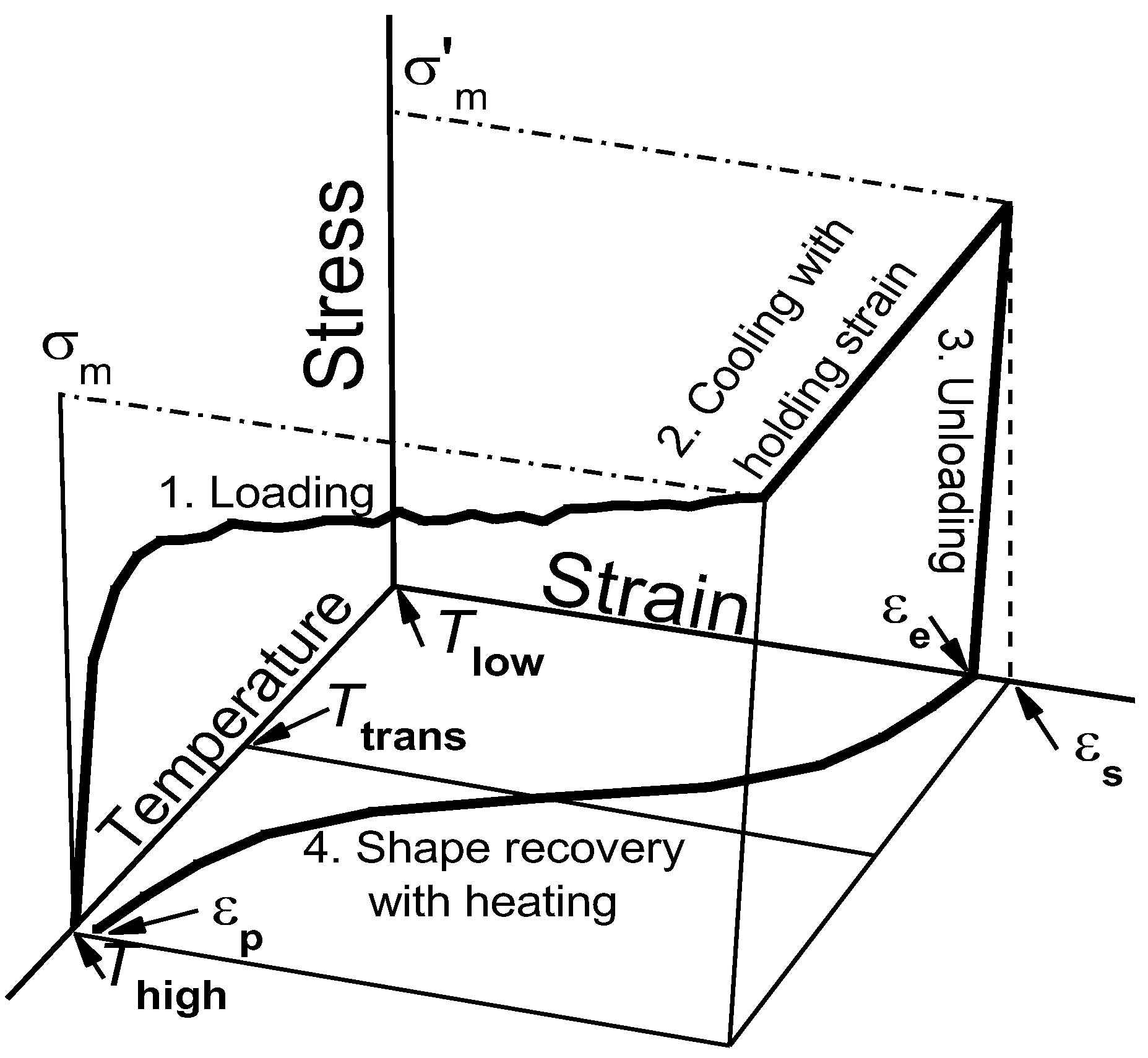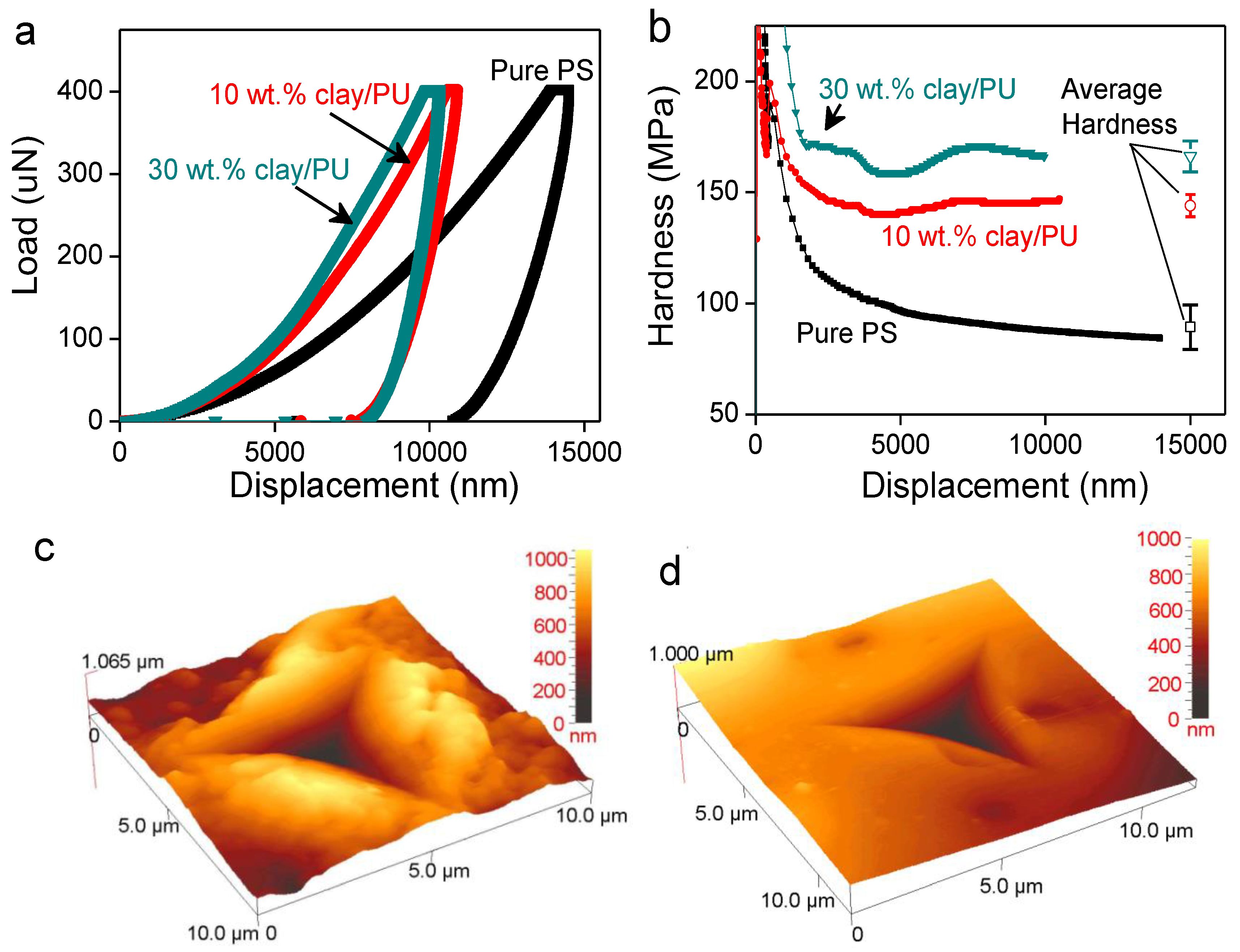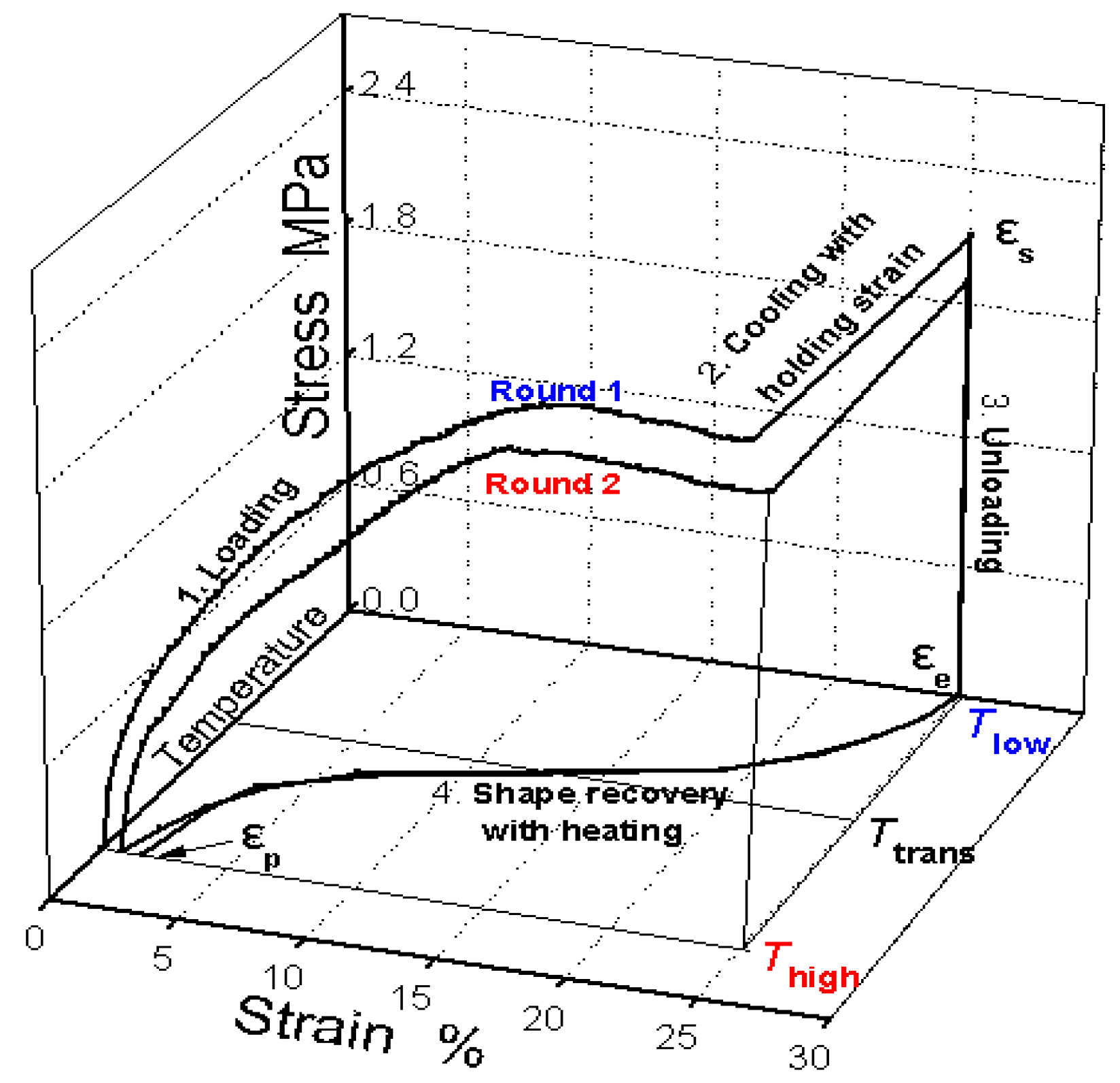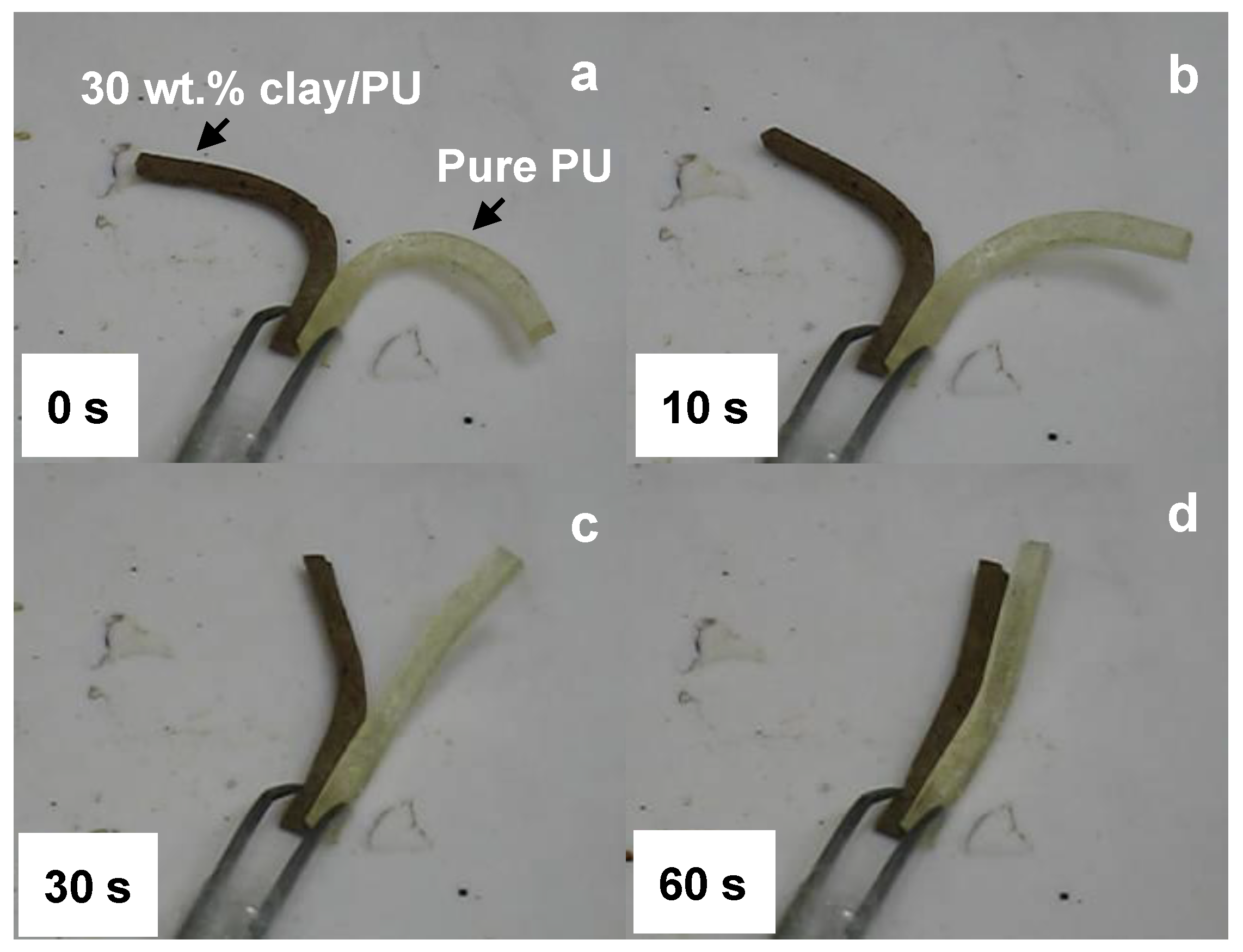Thermal-Mechanical Properties of Polyurethane-Clay Shape Memory Polymer Nanocomposites
Abstract
:1. Introduction
2. Materials and Methods
3. Results and Discussion
4. Conclusions
Acknowledgments
References
- Kim, B.K.; Lee, S.Y.; Xu, M. Polyurethanes having shape memory effects. Polymer 1996, 37, 5781–5793. [Google Scholar] [CrossRef]
- Baer, G.; Wilson, T.S.; Matthews, D.L.; Maitland, D.J. Shape-memory behavior of thermally stimulated polyurethane for medical applications. J. Appl. Polym. Sci. 2006, 103, 3882–3892. [Google Scholar] [CrossRef]
- Mohr, R.; Kratz, K.; Weigel, T.; Lucka-Gabor, M.; Moneke, M.; Lendlein, A. Initiation of shape-memory effect by inductive heating of magnetic nanoparticles in thermoplastic polymers. Proc. Natl. Acad. Sci. USA 2006, 103, 3540–3545. [Google Scholar] [CrossRef] [PubMed]
- Huang, W.M.; Yang, B.; An, L.; Li, C.; Chan, Y.S. Water-driven programmable polyurethane shape memory polymer: Demonstration and mechanism. Appl. Phys. Lett. 2005, 86, 114105. [Google Scholar] [CrossRef]
- Hayashi, S.; Kondo, S.; Kapadia, P.; Ushioda, E. Room-temperaturefunctional shape-memory polymers. Plast. Eng. 1995, 51, 29–31. [Google Scholar]
- Liang, C.; Rogers, C.A.; Malafeew, E. Investigation of shape memory polymers and their hybrid composites. J. Intell. Mater. Syst. Struct. 1997, 8, 380–386. [Google Scholar] [CrossRef]
- Gall, K.; Kreiner, P.; Turner, D.; Hulse, M. Shape-memory polymers for microelectromechanical systems. J. MEMS 2004, 13, 472–483. [Google Scholar] [CrossRef]
- Langer, R.; Tirrell, D.A. Designing materials for biology and medicine. Nature 2004, 428, 487–492. [Google Scholar] [CrossRef]
- Anderson, D.G.; Burdick, J.A.; Langer, R. Materials science: Smart biomaterials. Science 2004, 305, 1923–1924. [Google Scholar] [CrossRef]
- Balazs, A.C.; Emrick, T.; Russell, T.P. Nanoparticle polymer composites: Where two small worlds meet. Science 2006, 314, 1107–1110. [Google Scholar] [CrossRef]
- Utracki, L.A. Polymeric nanocomposites: Compounding and performance. J. Nanosci. Nanotechnol. 2008, 8, 1582–1596. [Google Scholar] [CrossRef] [PubMed]
- Carrado, K.A. Synthetic organo- and polymer-clays: preparation, characterization, and materials applications. Appl. Clay Sci. 2000, 17, 1–23. [Google Scholar] [CrossRef]
- Hussain, F.; Hojjati, M.; Okamoto, M.; Gorga, R.E. Review article: Polymer-matrix nanocomposites, processing, manufacturing, and application: An overview. J. Comp. Mater. 2006, 40, 1511–1575. [Google Scholar] [CrossRef]
- Carastan, D.J.; Demarquette, N.R. Polystyrene/clay nanocomposites. Int. Mater. Rev. 2007, 52, 345–380. [Google Scholar] [CrossRef]
- Ni, P.; Li, J.; Suo, J.S.; Li, S.B. Study on mechanical properties of polyurethane-attapulgite nanocomposites. J. Mater. Sci. 2004, 39, 4671–4673. [Google Scholar] [CrossRef]
- Wang, Z.Q.; Zhou, Y.M.; Sun, Y.Q. Preparation, characterization and infrared emissivity study of attapulgite@helical polyurethane composites. J. Inorg. Organmet. P. 2009, 19, 202–207. [Google Scholar] [CrossRef]
- Pan, H.X.; Chen, D.J. Preparation and characterization of waterborne polyurethane/attapulgite nanocomposites. Eur. Polym. J. 2007, 43, 3766–3772. [Google Scholar] [CrossRef]
- Bradley, W.F. The structural scheme of attapulgite. Amer. Mineral 1940, 25, 405–410. [Google Scholar]
- Galan, E. Properties and applications of palygorskite-sepiolite clays. Clay Miner. 1996, 31, 443–453. [Google Scholar] [CrossRef]
- Xu, B.; Huang, W.M.; Pei, Y.T.; Chen, Z.G.; Kraft, A.; Reuben, R.; De Hosson, J.T.M.; Fu, Y.Q. Mechanical properties of attapulgite clay reinforced polyurethane shape memory nanocomposites. Eur. Polym. J. 2009, 45, 1904–1911. [Google Scholar] [CrossRef]
- Pan, G.H.; Huang, W.M.; Ng, Z.C.; Liu, N.; Phee, S.J. Glass transition temperature of polyurethane shape memory polymer reinforced with treated/non-treated attapulgite (playgorskite) clay in dry and wet conditions. Smart Mater. Struct. 2008, 17, 045007. [Google Scholar] [CrossRef]
- Manika, E.; Maniks, J. Size effects in micro- and nanoscale indentation. Acta Mater. 2006, 54, 2049–2056. [Google Scholar] [CrossRef]
- Gao, Y.X.; Fan, H. A micro-mechanism based analysis for size-dependent indentation hardness. J. Mater. Sci. 2002, 20, 4493–4498. [Google Scholar] [CrossRef]
- Iost, A.; Bigot, R. Indentation size effect: Reality or artefact? J. Mater. Sci. 1996, 13, 3573–3577. [Google Scholar] [CrossRef]
- Kim, B.K.; Shin, Y.J.; Cho, S.M.; Jeong, H.M. Shape-memory behavior of segmented polyurethanes with an amorphous reversible phase: The effect of block length and content. J. Polym. Sci. B: Polym. Phys. 2000, 38, 2652–2657. [Google Scholar] [CrossRef]
- Lee, B.S.; Chun, B.C.; Chung, Y.C.; Sul, K.I.; Chos, J.W. Structure and thermomechanical properties of polyurethane block copolymers with shape memory effect. Macromolecules 2001, 34, 6431–6437. [Google Scholar] [CrossRef]
- Takahashi, T.; Hayashi, N.; Hayashi, S. Structure and properties of shape-emory polyurethane block copolymers. J. Appli. Polym. Sci. 1996, 60, 1061–1069. [Google Scholar] [CrossRef]
- Pissis, P.; Apekis, L.; Christtodoulides, C.; Niaounakis, M.; Kyritsis, A.; Nedbal, J. Water effects in polyurethane block copolymers Kyritsis, A.; Nedbal, J. J. Polym. Sci. B: Polym. Phys. 1996, 34, 1529–1539. [Google Scholar] [CrossRef]








Publisher’s Note: MDPI stays neutral with regard to jurisdictional claims in published maps and institutional affiliations. |
© 2010 by the authors. Licensee MDPI, Basel, Switzerland. This article is an open access article distributed under the terms and conditions of the Creative Commons Attribution (CC BY) license (https://creativecommons.org/licenses/by/4.0/).
Share and Cite
Xu, B.; Fu, Y.Q.; Huang, W.M.; Pei, Y.T.; Chen, Z.G.; De Hosson, J.T.M.; Kraft, A.; Reuben, R.L. Thermal-Mechanical Properties of Polyurethane-Clay Shape Memory Polymer Nanocomposites. Polymers 2010, 2, 31-39. https://doi.org/10.3390/polym2020031
Xu B, Fu YQ, Huang WM, Pei YT, Chen ZG, De Hosson JTM, Kraft A, Reuben RL. Thermal-Mechanical Properties of Polyurethane-Clay Shape Memory Polymer Nanocomposites. Polymers. 2010; 2(2):31-39. https://doi.org/10.3390/polym2020031
Chicago/Turabian StyleXu, Bin, Yong Qing Fu, Wei Min Huang, Yu Tao Pei, Zhen Guo Chen, Jeff T.M. De Hosson, Arno Kraft, and R. L. Reuben. 2010. "Thermal-Mechanical Properties of Polyurethane-Clay Shape Memory Polymer Nanocomposites" Polymers 2, no. 2: 31-39. https://doi.org/10.3390/polym2020031
APA StyleXu, B., Fu, Y. Q., Huang, W. M., Pei, Y. T., Chen, Z. G., De Hosson, J. T. M., Kraft, A., & Reuben, R. L. (2010). Thermal-Mechanical Properties of Polyurethane-Clay Shape Memory Polymer Nanocomposites. Polymers, 2(2), 31-39. https://doi.org/10.3390/polym2020031





